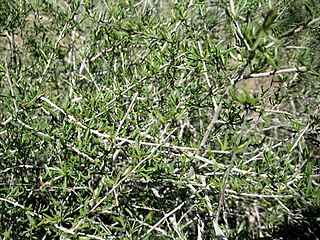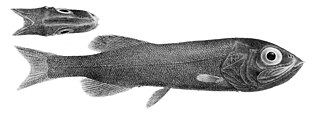
The Jebel Akhdar or Al Jabal Al Akhdar, is part of Al Hajar Mountains range in Ad Dakhiliyah Governorate of Oman. It rises to a height of 2,980 m (9,780 ft) and encompasses the Saiq Plateau at 2,000 m above sea level. Jebel Akhdar is famous for its labyrinth of wadis and terraced orchards, where pomegranates, apricots and roses grow in abundance due to its mild Mediterranean climate.

Searsia pyroides, previously known as Rhus pyroides, is a species of Searsia, native to southern Africa. This tree occurs throughout the whole of South Africa, a part of Botswana, Zimbabwe and Tanzania and in some areas of Namibia near Windhoek.

Ipomoea pes-caprae, also known as bayhops, bay-hops, beach morning glory or goat's foot, is a common pantropical creeping vine belonging to the family Convolvulaceae. It grows on the upper parts of beaches and endures salted air. It is one of the most common and most widely distributed salt tolerant plants and provides one of the best known examples of oceanic dispersal. Its seeds float and are unaffected by salt water.
Blanford's jerboa is a species of rodent in the family Dipodidae. It is native to Central Asia and is found in Turkmenistan, Uzbekistan, Afghanistan, Iran and Pakistan.

Quercus aucheri, the Boz-Pirnal oak is a species of oak tree in the family Fagaceae. It is found in limited portions of the Aegean islands of Greece and parts of Anatolian Turkey. It is placed in section Ilex.
Searsia brenanii is a species of plant in the family Anacardiaceae. It is endemic to Tanzania. It is threatened by habitat loss.
Rhus sp. nov. A is a species of flowering plant in the cashew family, Anacardiaceae, that is endemic to the Socotra Archipelago in Yemen. It can be found on the rocky slopes of wadis in drought-deciduous woodlands and succulent shrublands.
Searsia thyrsiflora is a species of plant in the family Anacardiaceae. It is endemic to Yemen. Its natural habitat is subtropical or tropical dry forests.

Pteropyrum is a genus of plants in the family Polygonaceae. Plants of the World Online accepts two species, native to Iran, Oman and the Gulf States.
Pierre Martin Rémi Aucher-Éloy was a French pharmacist and botanist who was a native of Blois. The standard author abbreviation Aucher is used to indicate this person as the author when citing a botanical name.

Searsia pentaphylla, the tizra tree, is a sumac shrub or small tree species in the genus Searsia found in North Africa, especially in Morocco and Algeria, the Levant, and Sicily.

Muscari aucheri, Aucher-Éloy grape hyacinth, is a species of flowering plant in the squill subfamily Scilloideae of the asparagus family Asparagaceae. It is a perennial bulbous plant, one of a number of species and genera known as grape hyacinths. Originally from Turkey, where it grows in grassy alpine areas, it is sometimes grown as an ornamental plant. The synonym M. tubergenianum may be found in the horticultural literature.

Searsia koefoedi, or Koefoed's searsid, is a species of tubeshoulder found in the oceans at depths of from 450 to 1,500 metres. It is named after Norwegian marine biologist Einar Koefoed.

Iris aucheri, the Aucher-Éloy iris, is a species of flowering plant in the family Iridaceae. It is a bulbous perennial in the Juno group of irises.

Searsia is a genus of flowering plants in the family Anacardiaceae.

Hypericum aucheri, also known as Koramanotu in Turkish, is a herbaceous perennial flowering plant in the St. John's wort family Hypericaceae.

Omanosaura cyanura, the blue-tailed lizard or blue-tailed Oman lizard, is a species of lizard in the family Lacertidae. It is found in Oman and the United Arab Emirates.

Al Hajar montane woodlands is a temperate grasslands, savannas and shrublands ecoregion in the Hajar Mountains of the eastern part of the Arabian Peninsula, which extends across portions of Oman and the U.A.E.
Ceratonia oreothauma is a species of tree native to Oman and Somaliland.













